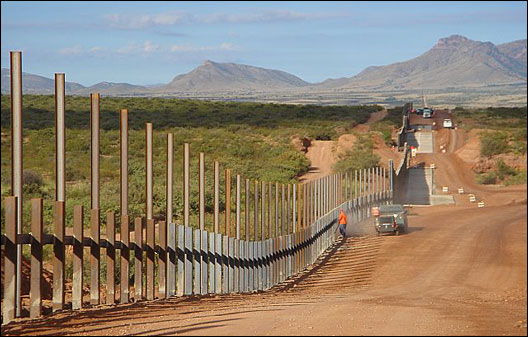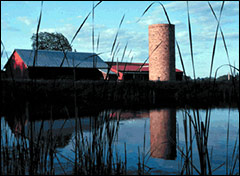
Defenders of WildlifeThe border fence under construction in Arizona.
The bobcat turned, looked at me, and jumped into the mesquite brush. It was the first day of a three-day visit to South Texas, and I was exploring the Santa Ana National Wildlife Refuge along the Rio Grande River. Seeing the bobcat was a treat for me — but the kind of treat that could become increasingly rare if the Bush administration and Congress go ahead with plans to build between 370 and 700 miles of double-layered concrete wall along the U.S.-Mexico border.
The efficacy of this plan to keep out “unwanted” foreigners is dubious at best, and highly controversial. But one thing is sure: it is likely to be the last nail in the coffin of some of the most extraordinary, and extraordinarily vulnerable, wildlife of the American Southwest.
Most of the wildlife of the border region has already been battered by more than a century of hunting, fencing, ranching, and agriculture. Ocelots, for instance — a kind of small, but equally spotted version of a leopard — once reached their northern limit in Arkansas and Louisiana. Now the 80 to 120 individuals still surviving in the United States cling to life along a small corridor of brush and forest along the Rio Grande — the last 5 percent of wild land in South Texas that hasn’t been cleared to make way for cotton, sorghum, and shopping malls.

This species could be in an ocelot of trouble.
Photo: El Aribabi / Sky Island Alliance
Like jaguars, pronghorn antelope, and other endangered creatures of the Southwest threatened by the wall, ocelots need to reach the larger breeding populations south of the border to maintain the viability of their species. But they’re unlikely to be able to climb over the wall planned under last year’s Secure Fence Act. The wall’s scale will equal or even dwarf some of the great human-made natural disasters of the past: perhaps the greatest similarity is to the railroads that divided the Great Plains bison into northern and southern herds that hastened their near-total destruction.
And this is no hypothetical barrier: Contractors have already built over 150 miles of it in Arizona and California. Later this year, Homeland Security Secretary Michael Chertoff plans to break ground on the Texas portion of the wall. And Senate Democrats are using $3 billion in funding for additional border wall construction to lure enough Republican votes to override President Bush’s expected veto of the Homeland Security appropriations bill.
If you haven’t heard about this great wildlife disaster in the making, it’s not that you haven’t been paying attention: despite the severity of the impact, until recently the nation’s largest environmental groups have been nearly silent about it. When you ask officials from those groups to explain the lack of email alerts, television ads, media blitzes, town hall meetings, and finely orchestrated lobbying pushes that have become the hallmark of a modern national environmental campaign, they usually say on the record that they’re still studying it.
But there’s more to the story.
When I called one top environmental group earlier this year, the spokesperson I reached said, “We’re just starting to look into the issue.” When I asked her repeatedly why her usually quick-off-the-mark organization hadn’t jumped faster onto this latest public-lands menace, she stonily repeated, “I can’t speak to that” over and over.
I was about to hang up the phone when she lowered her voice, asked me if she could speak privately, and whispered, “I’m really glad you’re doing this story” — an indicator of the deep misgivings within many groups about the lack of activity to stop the wall, and the desire among some environmentalists for external pressure to spur them into action.
It’s the Controversy, Stupid
Fighting for the planet usually involves a good deal of controversy, confrontation, and unusual alliances. But in this case, green groups have — until now — stayed as far away from confrontation as possible. Why? One word: immigration.
In recent years, the Sierra Club — the nation’s oldest and largest grassroots environmental group — has been pummeled by immigration infighting. The Club started doing serious outreach to minority communities in the mid-1990s, but worried that those efforts could be complicated by the Club’s longstanding position that America should “bring about the stabilization of the population first of the United States and then of the world” — a philosophy that could be interpreted as anti-immigrant. And so the board of directors adopted a new population policy, dropping its emphasis on “population stabilization” and focusing instead on some of the more international factors driving population increase in the United States and abroad, things like trade policy and access to birth control.
The policy change sparked a rebellion among Sierra Club population activists, who argued that immigration was indeed driving environmental destruction: when people migrate from low-consumption countries to high-consumption countries, they argued, their environmental impact usually skyrockets. These anti-immigration activists competed in a series of low-profile Board of Director elections, until by 2004 they were within striking distance of a takeover. But that year, an ugly lawsuit and extensive press coverage led to a record turnout by voting members — and the insurgency was trounced.
The wounds lingered, however, and not just for the Sierra Club. Other organizations took note of how the Club’s resources had been sucked up fighting a relatively unpopular clique of anti-immigration activists. The battle had taken desperately needed energy away from the Club’s main struggle: stopping the ongoing assault on clean air, clean water, open space, and endangered species. The nation’s environmental movement seemed to conclude from the Sierra Club’s fight that immigration was a topic to be addressed at great peril.
As a result, they decided to stay largely silent during the debate over the border wall. The legislative consequences of the environmental groups’ silence were immediate: with little opposition coming from the movement, in 2005 and 2006 Congress passed legislation allowing the Bush administration to waive any environmental laws that it decided got in the way of border security and explicitly authorized construction of 700 miles of the wall.
That damaging silence is now eroding as the impact of the wall becomes clear: two leading Sierra Club volunteers in South Texas, for instance, told me that while national Club officials had initially prohibited them from issuing statements to the media opposing the wall, they eventually relented and now permit local activists along the border to talk to the media. Sierra Club spokesperson Oliver Bernstein also told me that the Club now officially opposes “any plans for any systems of fences or walls that would unnecessarily endanger wildlife or protected areas.” And on Oct. 11, the Sierra Club and Defenders of Wildlife were granted a temporary restraining order to stop construction of the wall on the San Pedro National Conservation Area in Arizona.
However, neither the Sierra Club nor other groups have gone so far as to launch the kind of national campaign necessary to convince members of Congress outside of the border region to oppose the wall — leaving members of Congress free to push the project without scrutiny.
“We just really don’t want to do anything on the wall,” confirmed a senior Sierra Club volunteer who has helped formulate the Club’s population and immigration policy, “because the immigration debate is just a hornet’s nest.”
All’s Well That Ends Wall
Given what the immigration debate did to the Sierra Club, the caution is in some ways understandable, but a survey of immigration politics — in Washington and along the border — suggests that it’s also excessive. The fact is that few immigration opponents actually care deeply about building a wall — they just don’t think it will work.
Even when I spoke to Al Garza, executive director of the Minuteman Civil Defense Corps (the vigilante organization patrolling the border for illegal immigrants that has constructed several miles of fencing on private land), he told me that while his organization does prioritize border security and officially favors building a wall, their top priority is enforcing current laws against employers hiring undocumented workers and ending all government benefits for undocumented workers. “We don’t need to be talking about legislation [to build a wall],” he said. “If we address the hiring of illegal immigrants and don’t provide them public services, they will automatically go back home.”
That was the same sentiment shared by all five of the anti-immigration Sierra Club board members or former candidates I spoke to. “The most important thing is to enforce employer sanctions,” said former Democratic Colorado Gov. Dick Lamm, who ran for the Sierra Club board on the anti-immigration ticket in 2004. “That’s 10 or 15 times more effective than fencing. If we put species extinction and other impacts on the scale, [the wall is] just not going to be effective enough to make it worth all the negative impacts.”
Of the remaining four candidates I spoke with, two expressed some support for walls in certain places, and two said they were opposed: “A wall is useful in high traffic areas where there’s lots of garbage, but it’s not going to be the panacea that enforcing our employer laws is,” said Frank Morris, a former executive director of the Congressional Black Caucus who said he’s concerned that liberal immigration policies will lower wages for low-income and low-skilled workers.
Analysts on all sides seem to agree that the wall will do little to nothing to stop the flood of immigrants. “A 10-foot fence won’t do much to stop someone with an 11-foot ladder,” said Jim Manley, spokesperson for Senate Majority Leader Harry Reid (D-Nev.). The public doesn’t think walls work either: a recent New York Times poll found that, by a 68 to 15 margin, Americans preferred the idea of increasing border patrol staffing to building fences.
However, a 2006 NBC poll found that a significant majority of people said they would be more likely to vote for a candidate who favored building a fence along the border. And that may explain some of the momentum. Precisely because of the wall’s ineffectiveness in stanching the flow of people across the border, it’s the perfect solution for the many members of Congress who want to show their constituents they’re doing something about illegal immigration — without actually cutting off the supply of cheap labor demanded by Big Ag and the service industry.
In addition, immigrant advocate groups like the Catholic Church and the National Immigration Forum, who have in the past opposed construction of a wall, this summer supported immigration reform legislation that included it (and several other non-environmental provisions they had previously found objectionable) because they considered the overall legislation beneficial to immigrants.

Raúl Grijalva
Photo: house.gov
Nevertheless, local efforts along the border — complemented by modest activity and assistance from a handful of national organizations like Defenders of Wildlife and the Center for Biological Diversity — have produced some results. Earlier this year, Rep. Raul Grijalva (D-Ariz.) introduced a bill that would ensure that some of the worst elements of the border wall never happen: it would remove the exemption that border security activity gets from environmental laws; give the Secretary of Homeland Security the discretion to not build a wall if he decides it’s not warranted in an area; and make it easier for the Border Patrol to install a “virtual fence” — a system of electronic monitors that some experts think could help the Border Patrol stop illegal immigrants without having to build a wall. The bill only has a handful of cosponsors right now, but it received some high-profile support in late September in Edinburg, Texas, when House Speaker Nancy Pelosi told local press that the border wall was a “terrible idea.”
“These are communities that have a border going through them, they are not communities that should have a fence going up and splitting them,” she said.
Grijalva’s bill, a nod from Pelosi, and a growing on-the-ground movement, including local Sierra Club activism, have also broken down some of the national environmental groups’ reluctance to take on the issue. Soon after a June interview with National Audubon Society spokesperson Tony Iallonardo — who told me his group was still looking into the issue before adding, clearly conflicted, that the border region is “a spectacular area and it’s really kind of frightening to imagine what in a worst-case scenario the wall would do to bird watching” — the group decided to officially endorse the Grijalva bill. “We got a lot of concern from constituents in our border states about the issue,” said Audubon conservation policy director Mike Daulton.
Even the national Sierra Club has begun to fight the wall more aggressively, signing on to a letter endorsing Grijalva’s bill, featuring a brief article about it in its newsletter, and joining the lawsuit against the wall in the San Pedro Recreation Area. These activities may have produced some results: even as Homeland Security Secretary Michael Chertoff fast-tracks wall construction across the border region, early this month he said he was considering limiting the Texas wall to “as little as 40 or 50 miles.”
The big question now is whether Sierra, Audubon, and others will back their new position with the kind of resources necessary to take on the White House, members of both parties currently using the wall as a way to flex their anti-immigration muscle, and immigrant “advocates” who’ve shown that they’re willing to accept the wall as the political price for broader immigration reform.
It would be a long, tough battle — but no tougher than the battles the environmental movement has fought to keep the Southwest worth preserving in the first place.


